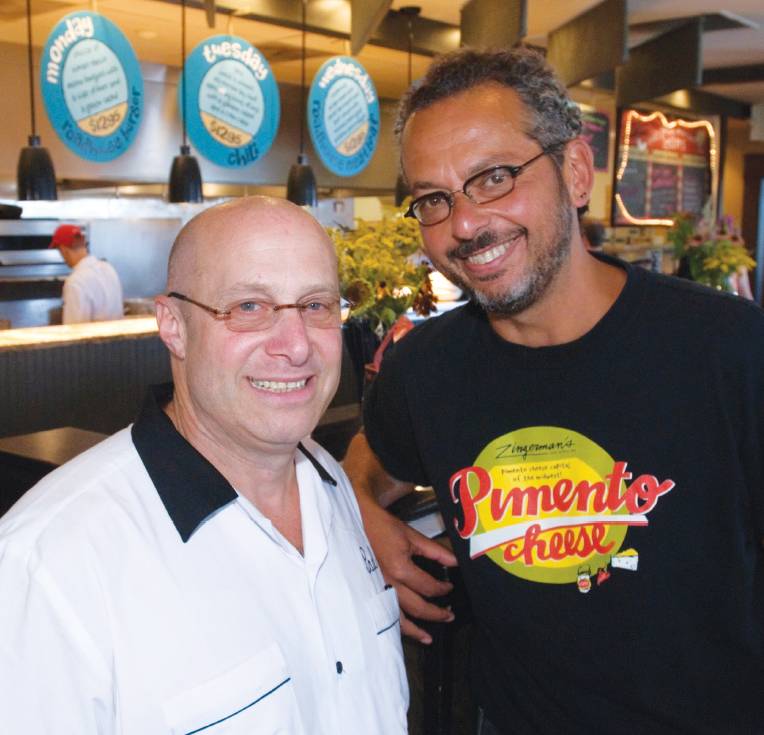

ZINGERMAN’S AT A GLANCE
Location: Ann Arbor, MI
Founded: 1982
Number of Employees: 585
Annual Revenue: $45.6 Million
Annual Profits: $1 Million
Sectors: Food, Consulting
Local Ownership: 100%
Local Sourcing: Over 60%
Mention the name “Zingerman’s” in Ann Arbor, Michigan and you’ll be hard-pressed to find someone who doesn’t smile. In the early ’80s, Paul Saginaw and Ari Weinzweig came together to open Zingerman’s Deli, a specialty food store and deli that serves overstuffed, now-world-famous sandwiches. Zingerman’s Deli became a local institution in Ann Arbor and quickly received national acclaim.
However, from day one, Saginaw and Weinzweig were adamant that they wanted their business to be truly unique, which meant that there could be only one. That meant they wouldn’t franchise their hugely successful brand. Simultaneously, they were faced with the challenge of how to dynamically grow the company to support their employees. After a decade in business, they found a solution – one that would not only provide them with the dynamic growth they were searching for, but that would bolster the local economy in Ann Arbor. The two men decided to create a network of 10 to 15 vertically integrated businesses that could support and supply each other and operate independently. The results and growth have been astounding and have created a model for true local economic prosperity. Paul Saginaw shared his story and insights on everything from open-book management to Zingerman’s creative employee ownership model.

“We approach things with an abundance mentality rather than a scarcity mentality. There is plenty to go around.”
THE STORY OF HOW ZINGERMAN’S DELI GOT STARTED
My partner Ari Weinzweig and I met in the late ’70s when we found ourselves both working in a restaurant in Ann Arbor. Ari was a recent graduate of the University of Michigan. I was working for the company that opened the restaurant as the general manager. On my first day there, Ari started as a dishwasher. We met and struck up a friendship. I had grown up in Detroit and he grew up in Chicago where every neighborhood had a delicatessen, but here we were, stuck in Ann Arbor. It was a wasteland – you couldn’t find a real quality sandwich – and we thought that Ann Arbor could use a good delicatessen.
I left that company and went off with a friend to open a fish market. Later, our landlord approached me and asked if I wanted to be partners with him and open a restaurant in a building he owned across the street, which I didn’t want to do. But I said I would love to rent the space from him and he was happy to do that. That was on a Saturday. On Sunday morning, I went to Ari’s apartment and woke him up and said, “It’s time for you to give notice at your job. I found a location for us to open the delicatessen we’ve been talking about.”
We sat down at his Smith Corona typewriter and typed out our business plan and our vision of what we wanted. We said that we were going to gather the finest artisan-made products from around the world and have a specialty food store, and smack down in the middle of it we were going to have this bustling sandwich shop serving overstuffed sandwiches. It was a very clear vision in our heads before we ever made our first sandwich. We also said that we wanted to be unique and, for us, by definition that meant that there is only one of you. If we were ever going to grow or expand, we would never do it by replication. That was not a model that interested us. We wanted to be great at what we were doing and we wanted to be unique, not necessarily big.
We borrowed $20,000 against my house and opened in March of 1982. We were right – people wanted to eat a good sandwich and they wanted to try all the different foods in the store. We were busy enough that when we first opened and our friends would come in to congratulate us, we’d throw them an apron and ask them to get behind the counter !

Paul Saginaw (left) and Ari Weinzweig (right)
THE TRANSITION FROM A DELI TO A COMMUNITY OF BUSINESSES
Things went really well for about the first ten years. We were winning awards, getting a lot of exposure in the media – it was a pretty heady time. But about ten years into it, I started to notice things in the work environment that caused me concern. Sales were flattening, profitability was going down, and it kind of seemed like people were just coming in and punching the clock. We also had a formal leadership team and there was a lot of disagreement among them about where our biggest opportunities were and how to take advantage of them. There was risk avoidance because we didn’t want to do anything crazy, but I thought we were really stopping the innovation.
Also, if you were up-and-coming in the organization and you wanted to grow professionally and financially, there wasn’t a lot of room for you because we were a young organization and had almost no turnover at the leadership level. You had to wait for somebody to die in order to move up and nobody was about to do that. We knew we were going to lose people because we didn’t provide them with growth opportunities. We knew we would end up losing people to our competition after we had taught them very well how to compete with us. That was a problem. Also, we wanted to provide a very robust benefits package to our staff. We wanted the people who worked for us to be able to afford to live in the community, raise families, and send children to school, and all of that was going to require dynamic growth. So, we had to come to terms with how we were going to stay true to our initial vision of not growing by replication but at the same time have dynamic growth and provide opportunities for our team.
So, one day I dragged Ari outside and I sat him down on the bench in front of the deli and I said, “You know, we’ve been at this for ten years. Ten years from now, what do we look like?” He goes, “Oh man, why are you bothering me? You know, the dishwasher called in sick, the cooler’s broken, and the lunch rush is about to start. I got real work to do.” I said, “Well, this is our real work.” I understand that the everyday pressures are very, very real, but somebody in the organization has to be looking down the road saying, “this is where we’re going.” When you have a business and people come in every day and put out a really great effort, they are giving you the gift of followership. In exchange for that gift, you owe them a debt and part of that debt is to provide a safe, inviting, inclusive workplace where they feel really good about coming every day. Part of that is a legacy of guiding principles that determine how we’re going to behave within this organization and the other part is an attractive, achievable, strategically sound, inspiring, widely shared vision of the future that says, “This is where we’re going and it’s going to be fantastic. You are part of it and this is the role you’re going to play.”
We went back and forth for a year trying to figure out who we were and where we wanted to go. We didn’t have any roadmap out there – we just had these ideas about the type of organization that we wanted to be. I remember I was in Seattle at the Elliott Bay bookstore and I came across this book “The End of Bureaucracy and the Rise of the Intelligent Organization” . I pretty much read the whole book just sitting there, went outside to the pay phone, called Ari and said, “I think I’ve just figured it out. Go out immediately and get this book. This might be the roadmap for us.” That started us thinking about what we wanted to do, and then we were at a conference in Washington, D.C. and we were listening to somebody lecture that was really boring. We walked outside, sat on the steps, and fully hatched this idea out for what we were going to do.
It was a long process though – about a year of going back and forth – but we came up with a 15-year vision that we called “Zingerman’s 2009” that said:
1) We were going to stay very local, but we would open 12 to 15 businesses, all in the Ann Arbor area, and all of them would carry the brand.
2) We were going to provide ownership opportunities in the brand to the people who worked for us.
3) We would partner with and finance those who came forward who were passionate about a product or service and were willing to operate according to our guiding principles and they would become part of this community of businesses.
4) We wouldn’t do anything unless it represented a quality improvement over what we were currently doing.
5) We wouldn’t be interested in something just because it was a market opportunity but because there was a passion and a willingness to go for greatness and market leadership.
6) We were going to be customers and suppliers of each other and we would have a shared services group so that when businesses were opening we would be able to provide a level of technical and administrative expertise that startups can’t afford but desperately need, in which the ongoing mature businesses would subsidize the startups because that would strengthen the brand and create new customers and suppliers for everybody.

“At its core, open-book management is inviting everybody to come in and help make the decisions that run the business.”
THE BENEFITS AND CHALLENGES OF USING OPEN-BOOK MANAGEMENT
We wanted a workplace where decisions were not made based on who had the most authority. We wanted to tap into the wisdom of everybody who worked there. It was something that we always had worked towards and then 15 years ago or so, we were introduced to a book written by Jack Stack and Bo Burling-ham called “The Great Game of Business.” Jack Stack had done a leveraged management buyout of a company called Springfield ReManufacturing Corporation where they took over a business that was really suffering and was straddled with a lot of debt. He was trying to figure out what to do and came upon this as a survival tool.
When people say “open-book management,” most of the time they think about sharing the financial information of a company with everybody who works there. While that is certainly true, at its core, open-book management is inviting everybody to come in and help make the decisions that run the business. In order to do that, people need all the information, and the financial information is one of the big tools that you need. Jack Stack had a process that was based on what they called weekly financial huddles. Either within the business or, if the business is big, within the acting department, you have a weekly meeting where there is a big white board up on the wall, which is essentially the profit and loss statement for that department. It looks like a financial statement – you have your line items, your sources of revenue, and your expenses. Next to each line item, there is the name of the employee who is responsible for that line. It is their responsibility to get the information up on the whiteboard in advance of this huddle and then to lead the discussion and report on their line item. It starts out driven by the annual plan with all of your planned sales or revenues and expenses for the week. Then we discuss what you actually did and what the variance was. If you’re beating the plan, we discuss what we’re doing right and how to keep doing more of it. If you’re lagging, we discuss what we’re going to do in order to get those numbers back on plan.
In most organizations, there’s a financial meeting where the accountant or the CFO are up there regurgitating what has happened historically. So the accountant holds all the financial information at the top, but the wisdom about what’s actually happening on the shop floor or on the retail line is held by the frontline staff. In most organizations, the people at the top think that people down at the bottom on the frontline are not concerned about this information, that they’re not smart enough to understand it, and can’t handle it. The people down on the frontline think the people at the top are kind of stupid and that they’re not really concerned about what really happens on the shop floor at the frontline with the customers.
Open-book management is a system that respects all parties and where information flows back and forth. You can have the dishwasher responsible for the sales figure and leading the discussion on how we’re going to meet our sales numbers. That huddle is where the real work of the organization happens.
In order to get people there, you have to train them beforehand so everybody speaks the same language, though. We have to account for things in the same way. So financial education is a big part of our training in our organization. In “The Great Game of Business,” they talked about business as a game. In any game, you have to know the rules, you have to keep score, and then we share the winnings. The annual plan is where everybody helps develop the rules and the numbers. We all know what level of profitability we have to hit in order for the business to be sustainable. Everything in excess of the planned numbers is the gain and that gain is shared with the staff. When the staff looks at all those numbers – sales, labor, net operating profit, breakage, etc. – they are also looking at the numbers that show them how much money is going into the sharing pool that they will be able to share in.
In terms of challenges, information is power and the people who traditionally hold this sort of information don’t readily want to give it up. They worry about job security. They worry about what people are going to do with those numbers. There’s a lot of baseless fear that comes from that. With the frontline staff, a lot of people were excited, but others saw it as us asking them to do a lot more work for the same amount of money or thought we were going to ask them to get interested in something that they didn’t really care about.
You have to fight through the resistance. Our organization is like any other organization. We generally have two reactions to change: people are either against it or they are really against it. So, you have to work through all of that and be willing to stick with it in order to give it the time it needs to get traction. It took 18 to 24 months to start to get the real traction, but I remember distinctly struggling with this for about 18 months and then one day watching a dishwasher who was in high school pick up an empty plastic jug of mayonnaise out of the recycling box and hold it up to the prep cook and say, “You didn’t take the spatula and get the rest of the mayonnaise out of there. That’s my profit-sharing check in there!” I was ready to cry. This high school kid had connected every single dot.
ALTERNATIVE METHODS OF EMPLOYEE OWNERSHIP
All the businesses are separately incorporated legal entities that don’t own each other. The common ownership between them is Ari and me. We couldn’t use a traditional employee ownership plan like a co-op or an ESOP because in order to do so, we would have to roll up into one organization. We really believe that who we are and where we are is greatly informed by how we are structured and we didn’t want to ever mess with that.
So we have these separate businesses, but then Ari and I have a business that we own together called Dancing Sandwich Enterprises, which holds our interest in each business, anywhere from 10 percent to 80 percent, because we’re partners with all the different businesses. It also owns the intellectual property and we license that to the businesses and that’s where our revenue comes from. We don’t take a salary from the businesses. Then the employees are each able to buy one share in that business for $1,000 that will entitle them to distributions every year that the businesses are profitable. We finance that $1,000 purchase with payroll deductions and then when they leave, they get their $1,000 back. The value of the share doesn’t really fluctuate – it’s more like a ticket to play the game. If things go well, they should get their $1,000 back in two years. That’s how they are participating in the financial performance of all the businesses together. So, even if they are at a business that lost money, if the whole community did well, they will get a distribution. So, the employee has a salary, they may be on a bonus plan based on meeting certain objectives, there is gain sharing within each of the businesses, and now there is another form of gain sharing that is community-wide.
It’s something we have wanted to do for a very, very long time. We wanted to share. It’s the same thing that drove us to allow the employees to become partners in the organization. Not everyone is going to become a partner, but we wanted everybody to be able to benefit. If you look at business not as existing to create wealth only for the ownership, but rather to provide everybody associated with it with a better life, and if you have a notion in your head that there is such a thing as having enough, it is extremely liberating. If the business adopts this, it gives you enormous freedom to be generous, to innovate, to experiment, to be creative, and to have a lot of fun. In order to do that, you have to have a desire to share and be generous with what you have. Ari and I approach things with an abundance mentality rather than a scarcity mentality. There is plenty to go around. It’s a lot more fun to operate that way. You may not get incredibly wealthy, but you will have an incredibly rich life.
LESSONS LEARNED ALONG THE WAY AND ADVICE FOR BUDDING ENTREPRENEURS
A great deal of who I am was informed by how I was raised. I was deeply informed by my grandfather, who was a small business man. He had a philosophy that said, “half of what you have belongs to those who need it,” and “if you’re successful, make the people around you successful.” He truly lived his life that way and that was just a huge influence on me. My grandfather also told me that you shouldn’t shit on the rungs as you climb the ladder of success because they are the same ones that you come back down on !
But for entrepreneurs, I would say imagine that your real work is to create a vision that describes the world that you want to live in. Then, with all your heart, give yourself over to that vision.
ZINGERMAN’S COMMUNITY OF BUSINESSES
A Revolutionary Business Model to Drive Local Economic Prosperity
HOW IT WORKS
- The community consists of ten operating businesses and one shared services business.
- Paul Saginaw and Ari Weinzweig are involved in all businesses in the community.
- All businesses are separate legal entities and have different ownership.
- All businesses source first from each other, then from other local sources.
- Partners meet every two weeks, where decisions are made that affect all businesses in the community.
- Decisions for all businesses are made by consensus.
- Employees of each business can participate in a profit-sharing program within each business and can also opt to purchase a form of stock in the entire community of businesses.
DANCING SANDWICH ENTERPRISES

ZINGERMAN’S SERVICE NETWORK
A shared services business that provides internal technical and administrative expertise, including finance, IT, marketing, and payroll, for all businesses in the community.
EFFECT ON THE LOCAL ECONOMY
“The result of the model is that Zingerman’s now has sales of over $40 million per year and has created over 550 jobs in the Ann Arbor economy. To me, that’s the way that economic development should work. In a given business, look at where it’s getting its inputs, find the value-adding opportunities, and try to make a map of different ways of building local self-reliance through that. To me, that kind of model, if it were practiced across the country, would put conventional economic development out of business.” // Michael Shuman, Community Economics Expert




